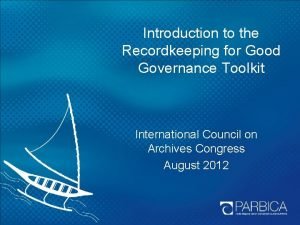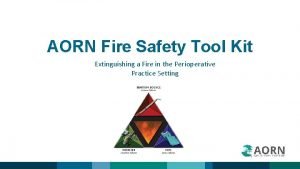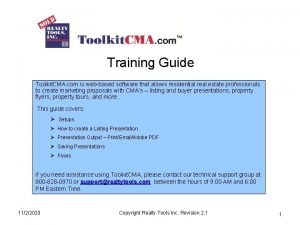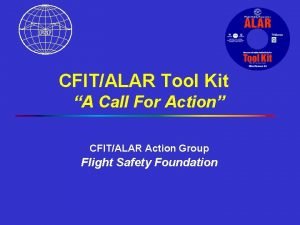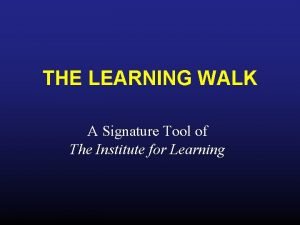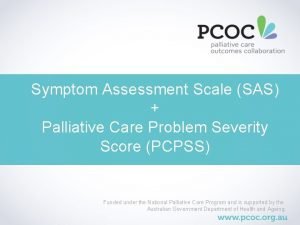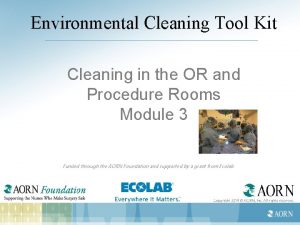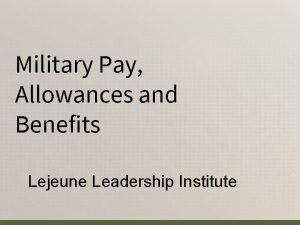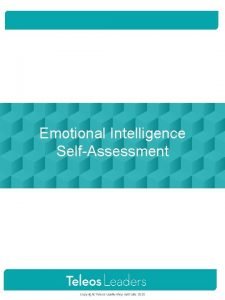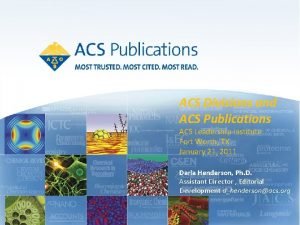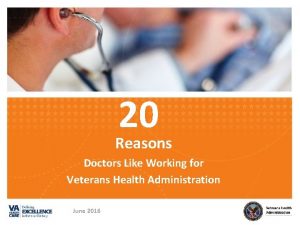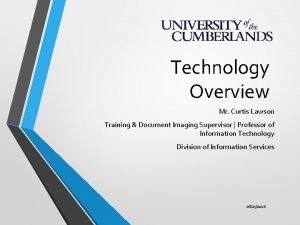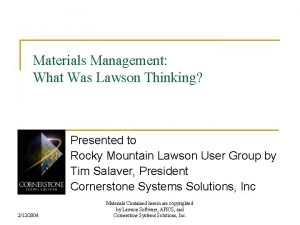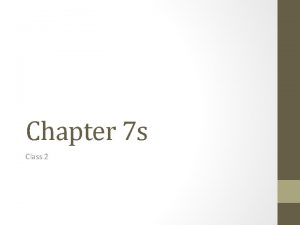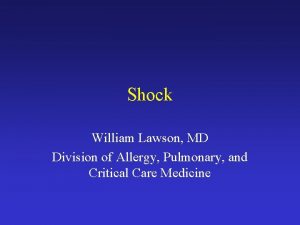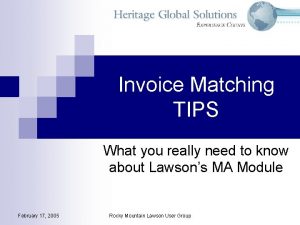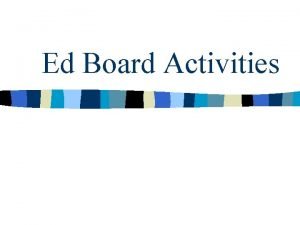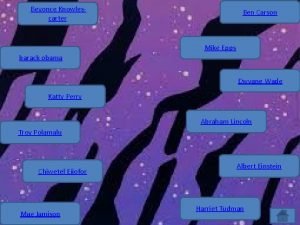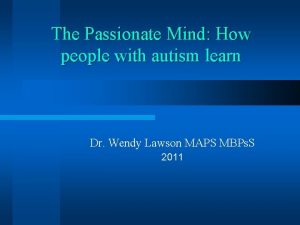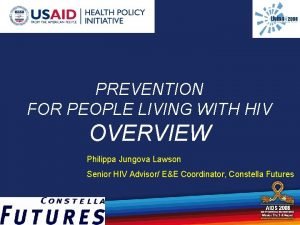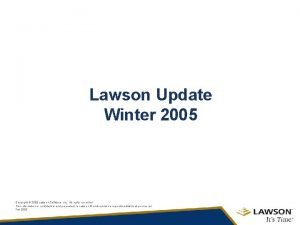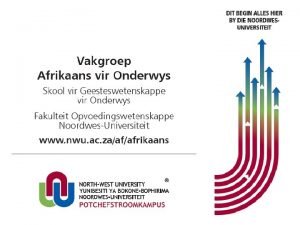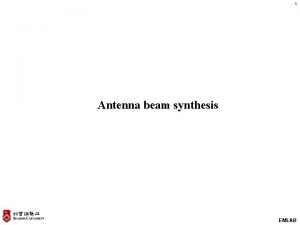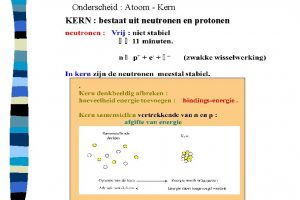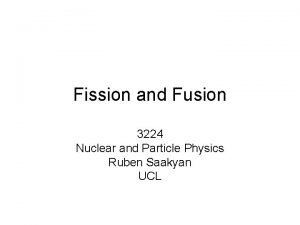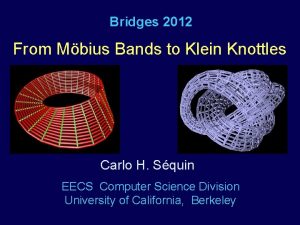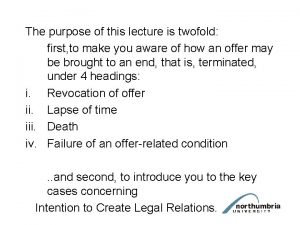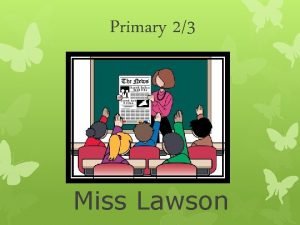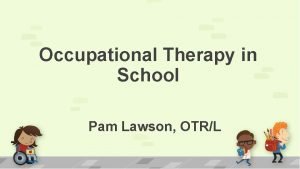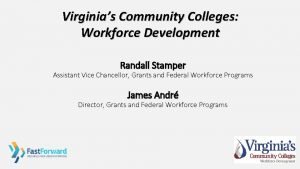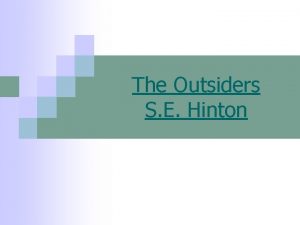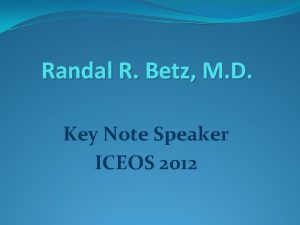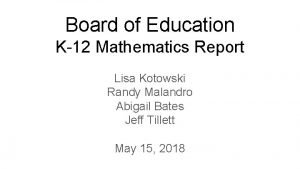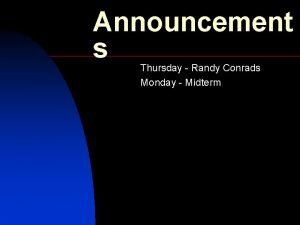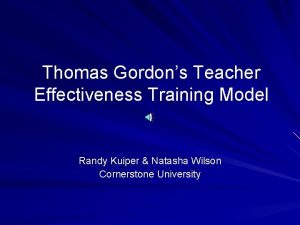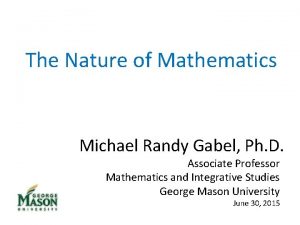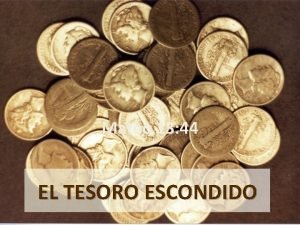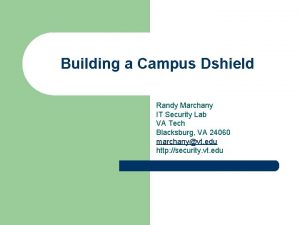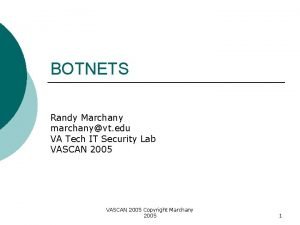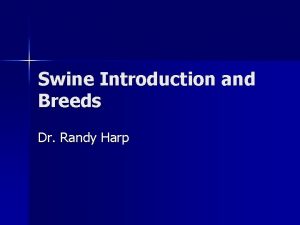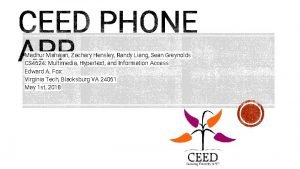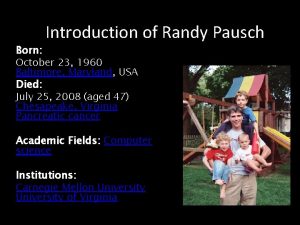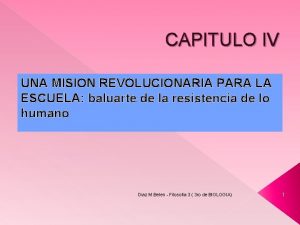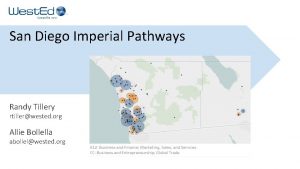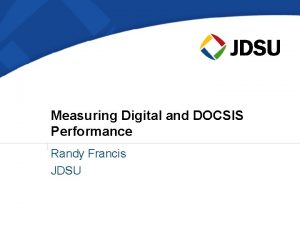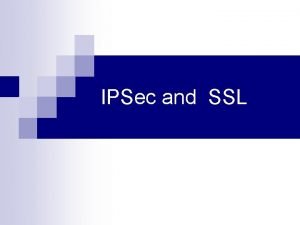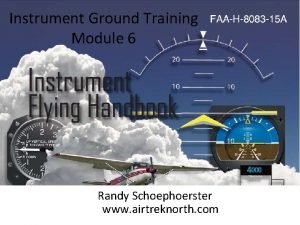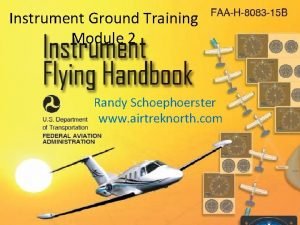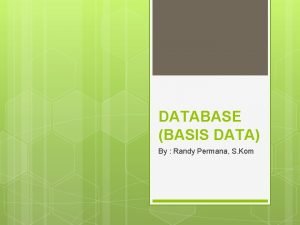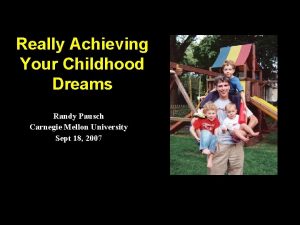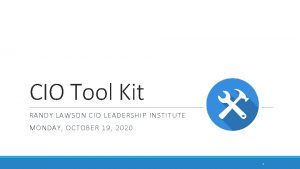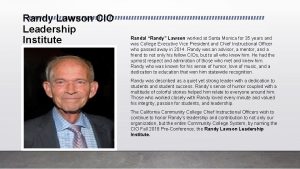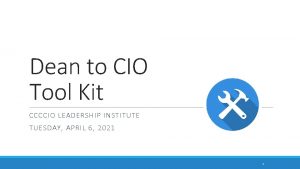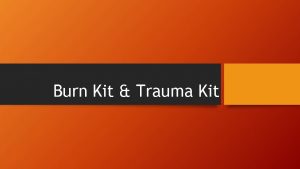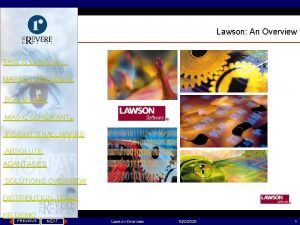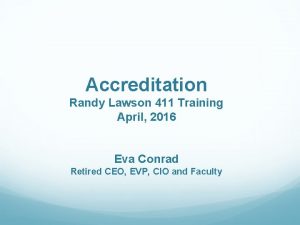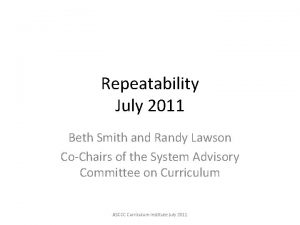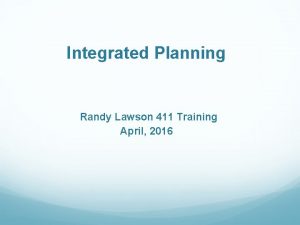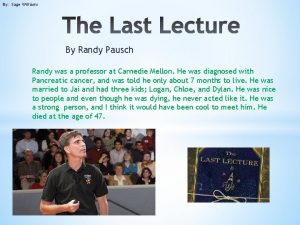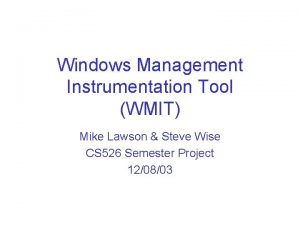CIO Tool Kit RANDY LAWSON CIO LEADERSHIP INSTITUTE
















































































- Slides: 80

CIO Tool Kit RANDY LAWSON CIO LEADERSHIP INSTITUTE TUESDAY, OCTOBER 22, 2019 1

Sheri Berger Pierce College (West Central Region - 6) Presenters Carol Farrar Riverside City College (Desert Region - 9) Brian Sanders Columbia College (Treasurer, East Central Region 5) 2

Session Overview 1. The Administrator’s Box 2. Top Drawer Tools 3. Attendance Accounting & Scheduling 4. Efficiency/Productivity & The Handy -Dandy Class Size Balancing Machine 5. Finding & Using Title 5 & Ed Code 6. MIS Coding, The Data Element Dictionary, & the SCFF 3

Working Inside the Administrator’s Box Guidelines & Regulations: Title 5, Ed Code, Student Attendance Accounting Manual Program and Course Approval Handbook Budget – Resource Allocation, Efficiency, and Prioritization College Program or Activity Minimum Qualifications – Credit or Noncredit Faculty Contract & College Organizational Chart Loads Stacked Loads Disciplines Cross-Listing 4

“Thinking Outside the Box” Guidelines & Regulations: Title 5, Ed Code, Student Attendance Accounting Manual Program and Course Approval Handbook Budget – Resource Allocation, Efficiency, and Prioritization College Program or Activity Minimum Qualifications – Credit or Noncredit Faculty Contract & College Organizational Chart Loads Stacked Loads Disciplines Cross-Listing 5

Moving the Boundaries of the Box • As CIOs, we have the … • • Guidelines & Regulations: Title 5, Ed Code, Student Attendance Accounting Manual Program and Course Approval Handbook Budget – Resource Allocation, Efficiency, and Prioritization College Program or Activity Minimum Qualifications – Credit or Noncredit Faculty Contract & College Organizational Chart Loads Stacked Loads Disciplines Cross-Listing Positional status Expertise Experience Voice at the table • To promote and achieve change and improvement • • Identify areas for change Educate about consequences of current situation Develop proposed solutions Work with other constituent groups to secure support (e. g. ASCCC, CBOs, CEOs) • Shepherd new ideas to fruition 6

CIOs as Change Agents ASCERTAIN THE LOCUS OF CONTROL EFFECTIVE CIO CHANGE AGENTS … • Local practice – College or District • Convincingly explain the “Why” • Local policy – College or District • Act collectively as the CCCCIO • Accreditation expectations • Maintain “sled dog” determination • Accreditation requirements • State guidelines for practice • Remain patient and trust the process • State regulations • State laws • Federal regulations and/or laws 7

Administrator’s Top Drawer Tools 1. Student Attendance Accounting Manual – website under construction 2. Program and Course Approval Handbook – latest version 3. Minimum Qualifications for Faculty and Administrators in California Community Colleges – latest version 4. Westlaw’s California Code of Regulations – Title 5 5. California Education Code 6. Chancellor’s Office Curriculum and Instruction Unit 7. The Course Outline of Record: A Curriculum Reference Guide Revisited – ASCCC, Spring 2017 8. Data Element Dictionary – Currently under reconstruction 8

Attendance Accounting & Scheduling FUNDAMENTALS, EXAMPLES, CASE STUDIES, AND CALCULATIONS FOR YOUR OWN DISTRICT 9

Fulltime Equivalent Student Factors in FTES calculation Section Overview • • Clock Hour vs Class Hour Passing Time and Break Time Partial Class Hour Multiple Hour Class Attendance Accounting Methods • Weekly Student Contact Hour • Daily Student Contact Hour • Actual Hours of Attendance (positive attendance) • Independent Study and Work Experience • Noncredit Distance Education 10

Full-time equivalent student (FTES) 1 FTES = 1 student 15 hours per week 2 semesters of 17. 5 weeks = 525 weekly student contact hours (WSCH) 11

Factors in FTES calculation Clock hour vs Class Hour Clock Hour • A 60 -minute time frame Class Hour • A period of not less than 50 minutes of scheduled instruction • There can be only one class hour in each clock hour, except as provided for multiple hour classes • A class hour is commonly called a “student contact hour” 12

Factors in FTES calculation Passing Time and Break Time • Each clock hour is composed of one class hour segment and a segment referred to as “passing time” or “break time” • No additional attendance may be claimed for the 10 -minute segment, except for multiple hour classes • The 10 -minute break time permitted in each clock hour may not be accumulated during a multi-hour block scheduled class to be taken all at once and be counted for FTES purposes. 13

Factors in FTES calculation Partial Class Hour A "partial class hour" is that fractional part of a class hour in a class scheduled for more than one clock hour 14

Factors in FTES calculation Multiple Hour Class • Any period of instruction scheduled continuously for more • • than one clock hour Each 50 minutes exclusive of breaks is a class/contact hour A fractional part of a class hour beyond the last full clock hour is counted from the 51 st minute of the last full clock hour No class break is allowed in the last full clock hour or the partial class hour The divisor for this fractional part of a class hour is 50. 15

Factors in FTES calculation Multiple Hour Class Calculation example 7: 00 pm to 10: 05 pm Partial Class Hour 9: 51 – 10: 05 = 15 min 15/50 = 0. 3 Total Contact Hour = 3. 3 Includes 20 min “break” time 16

Factors in FTES calculation Calculate Contact Hours Class meets from 0800 to 0850 0800 to 0905 0800 to 0950 0800 to 1005 0800 to 1030 0800 to 1225 Contact Hours 1. 0 1. 3 2. 0 2. 3 2. 8 4. 7 Breaks None One 10 -min Three 10 -min 17

Key to Hours Calculations 50 min + 10 -min break + 50 min + 10 -min break … + final session up to 95 minutes without a break Example: 190 min = 3. 4 apportionment hours is calculated this way: 50 min class + 10 min break = 1 st 60 -min hr = 1. 0 appt hr 50 min class + 10 min break = 2 nd 60 -min hr = 1. 0 appt hr Final 70 -min session with no breaks = 1. 4 appt hrs Total = 3. 4 appt hrs Hrs Min # Bk 1. 0 1. 3 1. 4 1. 5 1. 6 1. 7 1. 8 1. 9 2. 0 2. 3 2. 4 2. 5 2. 6 2. 7 2. 8 2. 9 3. 0 50 55 60 65 70 75 80 85 90 95 100 105 110 115 120 125 130 135 140 145 150 155 160 165 170 0 0 1 1 1 2 2 2 Bk Min 0 0 0 0 0 10 10 10 20 20 20 Hrs Min # Bk 3. 0 3. 3 3. 4 3. 5 3. 6 3. 7 3. 8 3. 9 4. 0 4. 3 4. 4 4. 5 4. 6 4. 7 4. 8 4. 9 5. 0 etc. 175 180 185 190 195 200 205 210 215 220 225 230 235 240 245 250 255 260 265 270 275 280 285 290 2 2 2 2 2 3 3 3 4 4 4 18 Bk Min 20 20 20 30 30 30 40 40 40

Interactive Moment Determine contact hours. Class meets… 1. Tuesdays from 6: 00 pm to 8: 50 pm 2. Tuesdays from 6: 00 pm to 9: 00 pm 3. Tuesdays from 6: 00 pm to 9: 05 pm 4. Monday & Wednesday from 8: 00 am to 10: 30 am 5. Monday from 12: 00 -1: 05 pm for lecture and Wednesday from 3: 00 -6: 05 pm for lab 6. Monday & Wednesday from 9: 00 to 10: 00 am for lecture then from 10: 00 am – 1: 00 pm for lab. 7. Thursday morning from 8: 00 -8: 30 am for lecture then from 8: 30 am to 2: 30 pm for lab. 19

Attendance Accounting Methods • Weekly Student Contact Hour • Daily Student Contact Hour • Actual Hours of Attendance (positive attendance) • Independent Study and Work Experience Education (includes credit or noncredit Distance Education courses) • Noncredit Distance Education 20

Attendance Accounting Methods Weekly Student Contact Hour • Primary terms only (fall/spring) • • Class is coterminous with primary term Meets regularly every week Same number of hours each week including TBA hours No deduction for holidays (i. e. holidays are “forgiven”) 21

Attendance Accounting Methods Census Week - WSCH • The week nearest to 20% of the number of weeks in the term • Census date is on Monday of census week Except if Monday is a holiday, then census date is the following day 22

Attendance Accounting Methods Term Length Multiplier (TLM) • TLM is the number of weeks in a primary terms with at least three days of instruction • The TLM for each college is set by the Chancellor’s Office based on the college’s academic calendar • Maximum TLM: 17. 5 for semesters • TLMs for 2019 -2020 (CCCCO. edu: search for Student Attendance Accounting Manual) Interactive moment: Find your TLM! 23

Attendance Accounting Methods FTES Calculation for WSCH 24

Interactive Moment Determine contact hours – Weekly Apportionment 1. Class meets Tuesdays from 6: 00 pm to 8: 50 pm (use 17. 5 weeks per term). Determine the total term contact hours. 2. Class meets Tuesdays from 6: 00 pm to 9: 05 pm (use 16. 4 weeks per term). Determine the total term contact hours. 3. Class meets Monday & Wednesday from 8: 00 am to 10: 30 am (use 16. 8 weeks per term). Determine the total term contact hours. 4. Class needs 52. 5 contact hours with two meetings per week (use 17. 5 weeks per term). How long is each session? What is your percent of target hours? (Scheduled hrs / COR hrs) 5. Class needs 90 contact hours with two meetings per week (use 16. 8 weeks per term) How long is each session? What is your percent of target hours? (Scheduled hrs / COR hrs) 6. Class needs 72 contact hours with four meetings per week (use 16. 4 weeks per term) How long is each session? What is your percent of target hours? (Scheduled hrs / COR hrs) 25

Working backwards from Course Outline of Record Determine Course Hours to Schedule 1. Get the expected hours on the Course Outline of Record 2. Divide by the TLM to get hours per week 3. Divide by the number of meetings per week to get hours per session 4. Round UP to the nearest tenth of an hour 5. Watch out for gray areas! 6. Check your math. Hrs/session x # sessions/wk x TLM. How many hours did you end up with? 1. 2. 3. Good practice: Exceed the hours on the COR by the least amount possible. Good practice: 100 -105% of COR hours You can schedule below the target but must meet or exceed minimums in Title 5 § 55002. 5 1. 2. 3. 16 hours of lecture + 32 hours outside class per unit 32 hours of activity + 16 hours outside class per unit 48 hours of laboratory unit 26

Attendance Accounting Methods Daily Student Contact Hour (DSCH) • Class meets five or more days • Meets regularly: the same number of hour on each scheduled day, including any TBA hours • NOT coterminous with primary term • Always used in summer, winter, and partial terms • (e. g. first 8 weeks, late-start 12 -week classes) • No hours counted for holidays (i. e. holidays not “forgiven”) • Option A: College loses those contact hours. Beware T 5 min hrs! • Option B: Extend class hours to cover missing holidays. 27

Attendance Accounting Methods Census Day - DSCH • The day of the class meeting that is nearest 20% of the number of days the course scheduled to meet • When census day falls on the first day the class meets, census is taken on the second day 28

Attendance Accounting Methods Course Length Multiplier (CLM) CLM is the number of days the course is scheduled to meet That is, the number of class meetings 29

Attendance Accounting Methods FTES Calculation for DSCH 30

Interactive Moment Determine contact hours – Daily Apportionment 1. Class meets M-Th for 5 wks minus 1 holiday from 8: 00 am to 10: 30 am. Find term hrs. 2. Class meets 8 Monday nights from 6: 00 pm to 9: 35 pm. Find term hrs. 3. Monday from 12: 00 -1: 05 pm for lecture and Wednesday from 3: 00 -6: 05 pm for lab for 6 weeks. No holidays. 4. Class needs 52. 5 contact hours with two meetings per week over 6 weeks. No holidays. How long is each session? What is your percent of target hours? 5. Class needs 90 contact hours with four meetings per week for 10 weeks with one holiday. How long is each session? What is your percent of target hours? 6. Class needs 36 hours of lecture and 108 hours of lab with 19 class meeting sessions, when holidays are removed. How do you schedule it? 31 Trick question!

Attendance Accounting Methods Actual Hours of Attendance (Positive Attendance) • Based on actual count of enrolled students present at each class meeting • Courses meeting fewer than five days • Courses irregularly scheduled for the number of days per week (full term) or number of hours on scheduled days (short term) • All face-to-face noncredit courses • Open entry/open exit courses • Calculation: divide the total hours of actual attendance by 525 32

Attendance Accounting Methods Independent Study and Work Experience Education 33

Interactive Moment Determine contact hours – Alternative Apportionment 1. 3 -unit lecture class meets online in your district for 3. 5 hours per week. How many contact hours are you paid for? 2. 3 -unit class with 2 units of lecture online (2. 2 hours per week online) and 1 unit of lab meeting face-to-face (3. 3 hours per week) for 16. 4 weeks. 3. Can you do 2. 2 hours per week online? 4. What if you have labs every other Saturday with F 2 F lectures? 5. What if you have labs every other Saturday with online lectures? 34

Attendance Accounting Methods Noncredit Distance Education Courses • First, a weekly student contact hour (WSCH) factor is calculated • That factor is used to calculate the student workload as of each of two census dates • First census: one-fifth in the length of each course • Second census: three-fifths point in the length of each course • Enrollment is counted as the average of these two. 35

Attendance Accounting Methods Deriving the WSCH Factor for noncredit distance education (1) Calculate the total number of hours of coursework required for a class: • • • The total number of hours of instruction to be received by students in the class. The number of hours expected for any outside-of-class work (as noted in the approved class outline), plus Any instructor contact as defined by Title 5 Section 55376(b). (2) Divide the sum of the hours as determined in (1) by 54 (a measure equating to a unit of credit similar to that used in credit distance education). (3) The resultant figure is the WSCH factor 36

Attendance Accounting Methods Calculating FTES for Noncredit Distance Education • Determine first census attendance at 1/5 point in term First census student contact hours is: WSCH Factor × # of students at first census × 17. 5 = Student Contact Hours • Determine second census attendance at 3/5 point in term Second census student contact hours is: WSCH Factor × # of students at second census × 17. 5 = Student Contact Hours • FTES is average of first and second census Student Contact Hours, divided by 525 Note: The factor of 17. 5 is to be used no matter what length the course. This is not a term length multiplier. 37

Attendance Accounting Methods FTES Calculation for Noncredit Distance Education - example 38

Interactive Moment Intricacies of Non-Credit Distance Education Apportionment 1. What do the 54 and 17. 5 in this calculation trace back to? 2. Do the two factors “relate”? 3. Is there homework in noncredit? 4. What about “office hours”? 5. Do you earn more or fewer hours with this average value? 6. Is this a prevalent methodology? 39

Efficiency/Productivity and the Handy-Dandy Class Size Balancing Machine AN OBJECT LESSON IN THE CUMULATIVE EFFECT OF 1000 SMALL ACTIONS 40

The Handy-Dandy Class Size Balancing Machine An object lesson and discussion 41

Finding and Using Title 5 and Education Code NAVIGATION, HOW-TO, AND CASE STUDIES 42

We now flip you over to last year’s awesome Title 5 and Education Code Presentation by Leandra Martin and Irene Malmgren! 43

Education Code & Title 5 DR. LEANDRA MARTIN: VICE PRESIDENT OF MISSION COLLEGE DR. IRENE MALMGREN: EMERITUS VICE PRESIDENT, INSTRUCTION, MT SAC 44

California Educational Code http: //leginfo. legislature. ca. gov/ Laws (started as Bills) passed by the California Legislature Can only be changed by legislation or budget action Education Code is the highest authority (informs Title 5) 45

California Education Code o Title 3 Postsecondary Education Division 7 Community Colleges Part 43 44 45 46 The California Community College Board of Governors Districts and Governing Boards District Reorganization of Formulation Part 47 Students Part Part Part 48 Community Colleges, Education Programs 49 Community Colleges, Educational Facilities 50 Finance 51 Employees 52 Career Technical Educations Pathways Program (repealed) 52. 5 California Community Colleges Economic and Workforce Development Program 53 Basic Skills Partnership Pilot Program 54 Community Colleges Basic Skills and Student Outcomes Transformation Program 54. 3 Student Success for Basic Skills Program 54. 5 Strong Workforce Program 54. 7 California College Promise Innovation Grant Program 46

California Education Code o Title 3 Postsecondary Education Division 7 Community Colleges Part 47 Students o Chapter 1 General Provisions o Chapter 1. 5 Student Records o Chapter 2 Fees o Chapter 3 Student Health Services and Supervisions 47

California Education Code o Title 3 Postsecondary Education Division 7 Community Colleges Part 47 Chapter 1. 5 • • • Article 1 Legislative Intent Article 2 Definition Article 3 General Provisions Article 4 Rights of Students Article 5 Privacy of Student Records 48

California Education Code o Title 3 Postsecondary Education Division 7 Community Colleges Part 47 Chapter 1. 5 Article 3 o § 76220 Regulations: establishment, maintenance, and destruction o § 76221 Notifying students of their rights under this chapter o § 76222 Log of persons and organizations requesting or receiving information o § 76223 Reasonable charge for transcripts; exceptions o § 76224 Grades: finalization: physical education class o § 76225 Transfer of records: notice of rights regulation 49

§ 76224 Grades: Finalization: Physical Education Class o (a)When grades are given for any course of instruction taught at a community college district, the grade given to each student shall be the grade determined by the instructor of the course and the determination of the grade by the instructor, in the absence of mistake, fraud, bad faith, or incompetency, shall be final. o (b) No grade of a student participating in a physical education class, however, may be adversely affected due to the fact that the student does not wear standardized physical education apparel where the failure to wear such apparel arises from circumstances beyond the control of the student. 50

Citation Education Code, Title 3, Division 7, Part 47, Chapter 1. 5, Article 3, § 76224 OR § 76224 § 70900 - § 88933 refer to Community Colleges 51

California Code of Regulations https: //govt. westlaw. com/calregs/Search/Index Commonly known as “Title 5” Regulations approved by Board Of Governors based on current Education Code is the higher authority 52

California Code of Regulations Title 1. General Provisions Title 15. Crime Prevention and Corrections Title 2. Administration Title 3. Food and Agriculture Title 4. Business Regulations Title 5. Education Title 7. Harbors and Navigation Title 8. Industrial Relations Title 9. Rehabilitative and Developmental Services Title 10. Investment Title 11. Law Title 12. Military and Veterans Affairs Title 13. Motor Vehicles Title 14. Natural Resources Title 16. Professional and Vocational Regulations Title 17. Public Health Title 18. Public Revenues Title 19. Public Safety Title 20. Public Utilities and Energy Title 21. Public Works Title 22. Social Security Title 23. Waters Title 24. Building Standards Code Title 25. Housing and Community Development Title 26. Toxics Title 27. Environmental Protection Title 28. Managed Health Care 53

California Code of Regulations Title 5 Division 1. California Department of Education Division 1. 5. Education Audit Appeals Panel Division 2. California State Library Division 3. Teachers' Retirement System Division 4. California Student Aid Commission Division 4. 5. Scholarshare Investment Board Division 5. Board of Trustees of the California State Universities Division 6. California Community Colleges Division 7. Board of Governors of the California Maritime Academy Division 7. 5. Private Postsecondary Education Division 8. Commission on Teacher Credentialing Division 9. Secretary for Education Division 10. The Regents of the University of California 54

California Code of Regulation Title 5 Division 6. California Community Colleges • Chapter 1. Board of Governors • Chapter 2. Community College Standards • Chapter 3. General Provisions • Chapter 4. Employees • Chapter 5. Students • Chapter 6. Curriculum and Instruction • Chapter 7. Special Programs • Chapter 8. Construction • Chapter 9. Fiscal Support • Chapter 10. Community College Administration 55

California Code of Regulation, Title 5, Division 6, Chapter 6: Curriculum and Instruction Subchapter 1. Programs, Courses and Classes Subchapter 2. Approval by the Chancellor Subchapter 3. Alternative Instructional Methodologies Subchapter 4. Programs and Classes Outside of District Subchapter 5. Educational Master Plans [Repealed] Subchapter 5. 5. Excursions and Field Trips [Repealed] Subchapter 6. Matriculation Programs Subchapter 7. Contract Education Subchapter 8. Academic Calendar Subchapter 9. Libraries Subchapter 11. New Colleges and Education Centers [Repealed] Subchapter 12. Libraries [Repealed] 56

California Code of Regulation, Title 5, Division 6: , Chapter 6, Subchapter 1: Programs, Courses and Classes Article 1. Program, Course and Classification and Standards Article 2. Grading and Academic Record Symbols Article 3. Probation and Dismissal Article 4. Course Repetition and Academic Renewal Article 5. Alternative Methods for Awarding Credit Article 6. The Associate Degree Article 7. Credit Certificates Article 8. Educational Master Plans 57

California Code of Regulation, Title 5, Division 6: , Chapter 6, Subchapter 1: Article 2: Grading and Academic Records Symbols § 55020. Regulations. § 55021. Grading Policies. § 55022. Pass-NO Pass Options. § 55023. Academic Record Symbols and Grade Point Average. § 55024. Withdrawal. § 55025. Grade Changes. 58

5 CCR § 55025. Grade Changes. (a) In any course of instruction in a community college district for which grades are awarded, the instructor of the course shall determine the grade to be awarded each student in accordance with this article. The determination of the student's grade by the instructor shall be final in the absence of mistake, fraud, bad faith, or incompetency. (b) For purposes of this section, “mistake” may include, but is not limited to, clerical errors and errors made by an instructor in calculating a student's grade. (c) Procedures for the correction of grades shall be consistent with Education Code section 76232 or provide an alternative mechanism which will ensure that students receive a reasonable and objective review of the requested grade change. If the procedure requires the student to first request a grade change from the instructor, provisions shall be made for another faculty member to substitute for the instructor if the instructor is not available, the student has filed a discrimination complaint or the district determines that it is possible there has been gross misconduct by the original instructor. (d) Procedures shall also include expunging the incorrect grade from the record. (e) When grade changes are made as a result of course repetition in accordance with article 4 of this subchapter, appropriate annotations of any courses repeated shall be entered on the student's permanent academic record in such a manner that all work remains legible, insuring a true and complete academic history. Note: Authority cited: Sections 66700 and 70901, Education Code. Reference: Sections 70901 and 76224, Education Code. HISTORY 1. New section filed 7 -17 -2007; operative 8 -16 -2007. Submitted to OAL for printing only pursuant to Education Code section 70901. 5 (Register 2007, No. 35). This database is current through 9/28/18 Register 2018, No. 39 5 CCR § 55025, 5 CA ADC § 55025 59

Citation • California Code of Regulation, Title 5, Division 6, Chapter 6, Subchapter 1: Article 2, § 55025. • OR • 5 CCR § 55025 • § 50001 - § 59606 refer to Community Colleges 60

Key sections from Title 5: 10 + 1 5 CCR § 53200 Definitions “Academic and professional matters” means the following policy development and implementation matters: ◦ ◦ ◦ (1) curriculum, including establishing prerequisites and placing courses within disciplines; (2) degree and certificate requirements; (3) grading policies; (4) educational program development; (5) standards or policies regarding student preparation and success; (6) district and college governance structures, as related to faculty roles; (7) faculty roles and involvement in accreditation processes, including self-study and annual reports; (8) policies for faculty professional development activities; (9) processes for program review; (10) processes for institutional planning and budget development; and (11) other academic and professional matters as are mutually agreed upon between the governing board and the academic senate. 61

Key sections from Title 5 5 CCR § 53200 Definitions ◦ “Consult collegially” means that the district governing board shall develop policies on academic and professional matters through either or both of the following methods, according to its own discretion: ◦ (1) relying primarily upon the advice and judgment of the academic senate; or ◦ (2) agreeing that the district governing board, or such representatives as it may designate, and the representatives of the academic senate shall have the obligation to reach mutual agreement by written resolution, regulation, or policy of the governing board effectuating such recommendations. 62

Interactive Moment The 10 + 1 in YOUR district 1. Which is stronger: “primarily rely” upon the academic senate or “mutual agreement” between the senate and district? 2. Find your district’s Board Policy regarding the 10+1. 3. Which items are “primarily rely” and which are “mutually agree”? 4. Do you have any “plus ones”? 63

Other key sections from Title 5 (See text on final slides of this presentation) ◦ 5 CCR § 53200 Definitions ◦ Definitions of faculty, Academic Senate, academic and professional matters, and consult collegially ◦ 5 CCR § 53021 Recruitment ◦ Recruitment of faculty, staff, and administrators ◦ 5 CCR § 55002 Standards and Criteria for Courses ◦ Degree-Applicable Credit Course ◦ Nondegree-Applicable Credit Course ◦ Noncredit Course ◦ Community Services Offering ◦ 5 CCR § 55002. 5 Credit Hour Definition 64

Title 5 is a VPI’s best friend IF IN DOUBT – LOOK IT UP! 65

Interactive Moment Practice with the new tools: Title 5 and Ed Code 1. How many hours do we have to schedule a 3 -unit class? 2. Can we add an English composition prerequisite to all our GE social sciences? 3. Can we hold a class for just the employees of a certain company? Just high school students? Inside a prison? 4. Where do we find “regular effective contact” for DE? Can we require training for online? 5. Can we have a wine-making program? 6. What are the General Education requirements for an AA/AS? 7. Can we offer a class in a neighboring district? 66 Trick question! BPC 25608!

MIS Coding, the PCAH, the Data Element Dictionary, & the SCFF WHAT KIND OF COURSE OR PROGRAM IS IT? AND DOES IT MATTER? 67

What you don’t know might bite you! Relationship between coding, results, and funding • Course and program types are outlined in the PCAH and Title 5 • MIS Codes (E. g. course basic “CB” series) are attached to each course and program • Students take courses and receive grades • Students complete the appropriate courses to earn degrees and certificates • State pays FTES for enrollments • State pays “supplemental allocation” based on student characteristics (MIS Upload) • State pays “success allocation” based on course and program completions and how those are coded 68

Interplay of Codes and Funding Particularly Relevant Codes – and their “Integrity Checks” • SCFF – Funds district for each student completing 9 or more CTE units in a year • CB 03 – Course TOP Code – Vocational top code drives funding for SWP • CB 09 – Course SAM Code (Note: Programming in COCI is even more restrictive here) • SCFF – Completing transfer-level math and English in a year. Stats for psych? Journalism as comp? • CB 25 – Course General Education Status (Check footer) • CB 04 – Course Credit Status • CB 05 – Course Transfer Status • CB 21 – Course Prior to College Level • How do we know if corequisite remediation is working? • CB 26 – Course Support Course Status • Higher funding for CDCP (Career Development and College Preparation) noncredit offerings. • CB 22 – Course Noncredit Category • CB 03 – Course TOP Code • CB 24 – Course Program Status 69

Questions and Answers 70

Sheri Berger bergersl@piercecollege. edu thank you Carol Farrar carol. farrar@rcc. edu Brian Sanders sandersb@yosemite. edu 71

Appendix TEXT OF KEY SECTIONS OF TITLE 5 CITED EARLIER IN THIS PRESENTATION 72

Key sections from Title 5 5 CCR § 53200 Definitions ◦ Faculty ◦ “Faculty” means those employees of a community college district who are employed in positions that are not designated as supervisory or management for the purposes of Article 5 (commencing with Section 3540) of Chapter 10. 7 of Division 4 of Title 1 of the Government Code, and for which minimum qualifications for hire are specified by the Board of Governors. ◦ Academic Senate ◦ “Academic senate, ” “faculty council, ” and “faculty senate” means an organization formed in accordance with the provisions of this Subchapter whose primary function, as the representative of the faculty, is to make recommendations to the administration of a college and to the governing board of a district with respect to academic and professional matters. For purposes of this Subchapter, reference to the term “academic senate” also constitutes reference to “faculty council” or “faculty senate. ” 73

Key sections from Title 5 5 CCR § 53021 Recruitment • Faculty, Staff & Administrators • “Except as otherwise provided in this section, community college districts shall actively recruit from both within and outside the district work force to attract qualified applicants for all vacancies”. 74

Key Sections from Title 5 5 CCR § 55002. Standards and Criteria for Courses. ◦ (a) Degree-Applicable Credit Course. ◦ (1) Curriculum Committee. ◦ (2) Standards for Approval. ◦ (A) Grading Policy. ◦ (B) Units. ◦ (C) Intensity. ◦ (D) Prerequisites and Corequisites. ◦ (E) Basic Skills Requirements. ◦ (F) Difficulty. ◦ (G) Level. ◦ (3) Course Outline of Record. ◦ (4) Conduct of Course. ◦ (5) Repetition. 75

Key Sections from Title 5 5 CCR § 55002. Standards and Criteria for Courses. (1) Curriculum Committee. The college and/or district curriculum committee recommending the course shall be established by the mutual agreement of the college and/or district administration and the academic senate. The committee shall be either a committee of the academic senate or a committee that includes faculty and is otherwise comprised in a way that is mutually agreeable to the college and/or district administration and the academic senate. 76

Key Sections from Title 5 5 CCR § 55002. Standards and Criteria for Courses. (b) Non degree-Applicable Credit Course. ◦ (1) Types of Courses. Non degree-applicable credit courses are: ◦ (A) Non degree-applicable basic skills courses ◦ (B) courses designed to enable students to succeed in degree-applicable credit courses ◦ (C) precollegiate career technical preparation courses ◦ (D) essential career technical ◦ (2) Standards for Approval ◦ (A) Grading Policy. ◦ (B) Units ◦ (C) Intensity. ◦ (D) Prerequisites and corequisites. ◦ (3) Course Outline of Record. ◦ (4) Conduct of Course. ◦ (5) Repetition. 77

Key Sections from Title 5 5 CCR § 55002. Standards and Criteria for Courses (c) Noncredit Course. (1) Standards for Approval. (2) Course Outline of Record. (3) Conduct of Course. (4) Repetition. 78

Key Sections from Title 5 5 CCR § 55002. Standards and Criteria for Courses. ◦ (d) Community Services Offering. A community services offering must meet the following minimum requirements: ◦ (1) is approved by the district governing board; ◦ (2) is designed for the physical, mental, moral, economic, or civic development of persons enrolled therein; ◦ (3) provides subject matter content, resource materials, and teaching methods which the district governing board deems appropriate for the enrolled students; ◦ (4) is conducted in accordance with a predetermined strategy or plan; ◦ (5) is open to all members of the community willing to pay fees to cover the cost of the offering; and ◦ (6) may not be claimed for apportionment purposes. 79

Key Sections from Title 5 5 CCR § 55002. 5. Credit Hour Definition ◦ (a) One credit hour of community college work (one unit of credit) shall require a minimum of 48 semester hours of total student work or 33 quarter hours of total student work, which may include inside and/or outside-of-class hours. ◦ (b) A course requiring 96 hours or more of total student work at colleges operating on the semester system or 66 hours or more of total student work at colleges operating on the quarter system shall provide at least 2 units of credit. ◦ (c) Cooperative work experience courses defined in section 55252 shall adhere to the formula for credit hour calculations identified in section 55256. 5. ◦ (d) For programs designated by the governing board as clock hour programs, units of credit shall be awarded in a manner consistent with the provisions of 34 Code of Federal Regulations part 600. 2. ◦ (e) Credit hours for all courses may be awarded in increments of one unit or less. ◦ (f) The governing board of each community college district shall establish policy, consistent with the provisions of this section, 80
 Randy lawson
Randy lawson Sanctuary model tool kit
Sanctuary model tool kit Esu pencil
Esu pencil Corporate governance tool kit
Corporate governance tool kit Aorn fire risk assessment tool
Aorn fire risk assessment tool Workforce tool kit
Workforce tool kit Toolkitcma login
Toolkitcma login Cfit alar
Cfit alar Tool kit learning walk
Tool kit learning walk Problem severity score
Problem severity score Ecolab housekeeping tool kit
Ecolab housekeeping tool kit Lejeune leadership institute
Lejeune leadership institute Teleos leadership
Teleos leadership Acs leadership institute
Acs leadership institute Va healthcare leadership talent institute
Va healthcare leadership talent institute Leadership institute texas state
Leadership institute texas state Transactional leadership vs transformational leadership
Transactional leadership vs transformational leadership Adaptive leadership style
Adaptive leadership style Capable but cautious performer
Capable but cautious performer Myuc cumberlands
Myuc cumberlands Leanna lawson
Leanna lawson Lawson materials management
Lawson materials management Lawson denver health
Lawson denver health Criminal profiling serial killers
Criminal profiling serial killers Clay lawson and russell odom
Clay lawson and russell odom James lawson's bed and breakfast in a small historic
James lawson's bed and breakfast in a small historic Max lawson oxfam
Max lawson oxfam William lawson md
William lawson md Invoice matching process
Invoice matching process Mr lawson ict
Mr lawson ict Swot analysis of organic products
Swot analysis of organic products Mike epps obama
Mike epps obama The passionate mind
The passionate mind Philippa lawson
Philippa lawson Lawson software training
Lawson software training Onderwereld opstel vrae
Onderwereld opstel vrae Sarah lawson usaid
Sarah lawson usaid Woodward lawson method
Woodward lawson method Welcome to ict
Welcome to ict Lawson kriterium
Lawson kriterium Lawson criterion
Lawson criterion Lawson klein bottle
Lawson klein bottle Bowerman v abta
Bowerman v abta Miss behavien
Miss behavien Pam lawson
Pam lawson Potter's tool is data cleaning tool
Potter's tool is data cleaning tool Randy stamper
Randy stamper Randy pausch time management
Randy pausch time management Personality traits of steve randle from the outsiders
Personality traits of steve randle from the outsiders Randy pausch the last lecture summary
Randy pausch the last lecture summary Randy pausch time management summary
Randy pausch time management summary D. randy garrison
D. randy garrison Randy betz
Randy betz Randy robinson
Randy robinson Fundamentals of web development randy connolly ppt
Fundamentals of web development randy connolly ppt Randy malandro
Randy malandro Randy unger
Randy unger Randy conrads
Randy conrads Randy kuiper
Randy kuiper Randy theorem
Randy theorem Randy oliver varroa
Randy oliver varroa Mt 13:44
Mt 13:44 L randy knight
L randy knight Randy marchany
Randy marchany Randy marchany
Randy marchany Randy harp
Randy harp Pearson
Pearson Randy liang
Randy liang Randy pausch biography
Randy pausch biography Randy sparkman
Randy sparkman Randy tillery
Randy tillery Randy francis
Randy francis Randy's path plus
Randy's path plus Ssl protocol stack
Ssl protocol stack Randy schoephoerster
Randy schoephoerster Randy schoephoerster
Randy schoephoerster Randy smith ups
Randy smith ups Randy permana
Randy permana Peas porridge hot meaning
Peas porridge hot meaning Randy pittman
Randy pittman Randy pausch childhood dreams
Randy pausch childhood dreams



